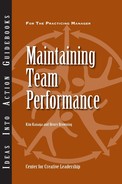Assessing Your Team’s Performance

The six dimensions of effectiveness provide structure for your assessment of your team’s key components. If any one of them is significantly weak, the team’s opportunity for peak performance is compromised. But how does a team leader perform diagnostics on a team that seems to be struggling in one of these six areas? One way is to use the four performance indicators to locate the source of the problem. The assessments on pages 26–29 allow you to bring both of these perspectives – the indicators of team performance and the dimensions of effective teams – together as a means for conducting regular team check-ups. They spell out the relationships between the dimensions of effectiveness and the indicators that spotlight problems in specific aspects of team performance.
Diagnosing Team Effectiveness
Use the performance indicators in the assessments that start on page 26 to locate problems in any one of the effectiveness dimensions and to diagnose where an under-performing team is having trouble. If the team doesn’t seem to be expending enough effort to hit its milestones, for example, check under the Effort label.
In this example, you could go through each of the six effectiveness dimensions listed under the effort label to assess whether the team is exerting sufficient effort toward establishing the purpose of the team, making the most of the team’s structure, soliciting organization support, developing effective relationships among members, maintaining relationships with external stakeholders, and managing and communicating information. During your assessment, you may determine that the team understands its purpose, has the appropriate structure, and has good relationships within the group and with outside stakeholders. But you identify organizational support as the culprit in the team’s lack of effort. Team members’ compensation and bonuses are based on individual contributions and provide little financial incentive for carrying out team tasks. By assessing and analyzing the situation this way you are able to pinpoint not just the source of the problem, but also to begin work toward a solution – in this case, some form of financial reward for team performance.
If the problem isn’t plainly signaled by one of the four indicators, you can also approach your diagnosis through the six dimensions of effective teams. For example, you might pick up on an atmosphere of backstabbing and blaming in a team made up of members from different functional areas of the organization. Looking at the internal cooperation and relationships dimensions under each performance indicator, you could track down the cause of the strife. Is it a problem of insufficient effort, inadequate knowledge and skills, off-kilter tactics, or just bad group dynamics? If the team started off functioning cooperatively and the members exhibit good interpersonal skills in other settings, you could eliminate group dynamics and knowledge/skills as indicating the cause of the current bad blood. As you think about what has changed for the team, you remember that in the interests of time and efficiency the team has eliminated all face-to-face meetings. This new tactic has fostered the resurgence of turf mentality and distrust. The source of the problem, then, is in the team’s tactics. The solution may be to reinstate meetings and provide other occasions for personal contact.
Although the assessments include questions you can ask to help in your diagnosis, they are not exhaustive and are designed only to give you ideas for your own questions. Each team faces unique challenges, each has a unique collection of individuals, each works to accomplish a unique task. As a team leader you can use the general structure of this assessment (the dimensions and indicators of team effectiveness that are common to all teams) and then review your team’s particular situation to devise questions that will help you define the problem and come up with a solution.
